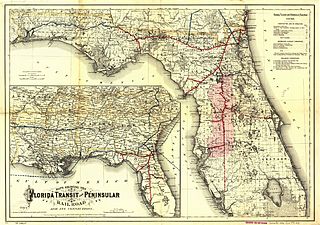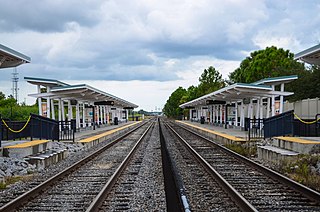
The Seaboard Coast Line Railroad was a Class I railroad company operating in the Southeastern United States beginning in 1967. Its passenger operations were taken over by Amtrak in 1971. Eventually, the railroad was merged with its affiliate lines to create the Seaboard System in 1983.

The Seaboard Air Line Railroad, which styled itself as "The Route of Courteous Service", was an American railroad that existed from April 14, 1900, until July 1, 1967, when it merged with the Atlantic Coast Line Railroad, its longtime rival, to form the Seaboard Coast Line Railroad. Predecessor railroads dated from the 1830s and reorganized extensively to rebuild after the American Civil War. The company was headquartered in Norfolk, Virginia, until 1958, when its main offices were relocated to Richmond, Virginia. The Seaboard Air Line Railway Building in Norfolk's historic Freemason District still stands and has been converted into apartments.

The South Florida Railroad was a railroad from Sanford, Florida, to Tampa, Florida, becoming part of the Plant System in 1893 and the Atlantic Coast Line Railroad in 1902. It served as the southernmost segment of the Atlantic Coast Line's main line. The line remains in service today and is now part of the Central Florida Rail Corridor in the Orlando metro area. The rest of the line remains under the ownership of CSX Transportation as part of their A Line.

The Sunset Limited is a long-distance passenger train run by Amtrak, operating on a 1,995-mile (3,211 km) route between New Orleans and Los Angeles. Major stops include Houston, San Antonio and El Paso in Texas, as well as Tucson, Arizona. Opening in 1894 through the Southern Pacific Railroad, Sunset Limited is the oldest continuously operating named train in the United States.

The Florida Central and Peninsular Railroad was the final name of a system of railroads throughout Florida, becoming part of the Seaboard Air Line Railway in 1900. The system, including some of the first railroads in Florida, stretched from Jacksonville west through Tallahassee and south to Tampa. Much of the FC&P network is still in service under the ownership of CSX Transportation.

The Old Gainesville Depot is a historic site at 203 Southeast Depot Avenue in Gainesville, Florida. It is located along the Gainesville-Hawthorne Trail State Park.

The Ocala Union Station is a bus station and former train station in Ocala, Florida, United States. It is located at 531 Northeast First Avenue, and was built in 1917 by both the Atlantic Coast Line and Seaboard Air Line Railroad. Prior to this, ACL and SAL had separate depots in Ocala. The former ACL station was originally built by the Florida Southern Railroad, while the former SAL station was built by the Florida Transit and Peninsular Railroad. On December 22, 1997, it was added to the U.S. National Register of Historic Places.

Winter Haven station is a train station in Winter Haven, Florida, served by Amtrak, the national railroad passenger system of the United States. It was originally built in 1925 by the Seaboard Air Line Railway, and was rebuilt in 1947. It included a freight depot which was located on the south side of the station until 1982, and was torn down after Seaboard Coast Line Railroad merged with Louisville and Nashville Railroad the next year. Today, after a series of mergers, the station track is owned by CSX Transportation. Tracks that cross the platform on the south side of the station serve as an interchange point between CSX Transportation and the Florida Midland Railroad Gordonville Subdivision.

Mobile station was a train station in Mobile, Alabama. It was built in 1956 and demolished in 2007.
The Gulf Wind was a streamlined passenger train inaugurated on July 31, 1949, as a joint operation by the Louisville and Nashville Railroad and the Seaboard Air Line Railroad. The Gulf Wind replaced the heavyweight New Orleans - Florida Express on this routing. The Gulf Wind was a limited stops train and offered amenities such as dining cars and Pullman service. The train left Jacksonville at night and arrived in New Orleans in the evening, as the Express had done.

Waldo station is a former train station in Waldo, Florida along the CSX S-Line. It serves Amtrak Thruway buses and previously served trains for Amtrak and other rail operators. The station is located at the interchange of US 301 and State Road 24 in Waldo, Florida.

The Pensacola and Atlantic Railroad (P&A) was a company incorporated by an act of the Florida Legislature on March 4, 1881, to run from Pensacola to the Apalachicola River near Chattahoochee, a distance of about 160 miles (260 km). No railroad had ever been built across the sparsely populated panhandle of Florida, which left Pensacola isolated from the rest of the state. William D. Chipley and Frederick R. De Funiak, both of whom are commemorated in the names of towns later built along the P&A line, were among the founding officers of the railroad company.
The Florida Central and Western Railroad was a rail line built in the late 1800s that ran from Jacksonville west across North Central Florida and the part Florida Panhandle through Lake City and Tallahassee before coming to an end at Chattahoochee. The line was later part of the Seaboard Air Line Railroad network from 1903 to 1967, and was primarily their Tallahassee Subdivision. The full line is still in service today and is now part of the Florida Gulf and Atlantic Railroad.
The Jacksonville & Southwestern Railroad (J&SW) was a railroad that served Florida from 1899 to 1904. It was purchased by the Atlantic Coast Line Railroad in 1904. The Atlantic Coast Line would extend the line further west and it would become their Jacksonville—Wilcox Line. Some of the original right-of-way was converted to a recreational path in the rails to trails program in the 1990s.

The Seaboard–All Florida Railway was a subsidiary of the Seaboard Air Line Railroad that oversaw two major extensions of the system in the early 1920s to southern Florida on each coast during the land boom. One line extended the Seaboard's tracks on the east coast from West Palm Beach down to Fort Lauderdale and Miami, while the other extension on the west coast extended the tracks from Fort Ogden south to Fort Myers and Naples, with branches from Fort Myers to LaBelle and Punta Rassa. These two extensions were heavily championed by Seaboard president S. Davies Warfield, and were constructed by Foley Brothers railroad contractors. Both extensions also allowed the Seaboard to better compete with the Florida East Coast Railway and the Atlantic Coast Line Railroad, who already served the lower east and west coasts of Florida respectively.
The Florida Western and Northern Railroad was a subsidiary of the Seaboard Air Line Railroad that expanded their network in the 1920s by building a rail line from Coleman, Florida all the way to West Palm Beach via Auburndale and Sebring, a distance of 204 miles. The line would be extended to Miami by the Seaboard-All Florida Railway, another Seaboard Air Line subsidiary, shortly after with the full line from Coleman to Miami becoming the Seaboard Air Line's Miami Subdivision. The line is still in service today from Auburndale to West Palm Beach and is now operated by Seaboard successor CSX Transportation as their Auburndale Subdivision.

Sanford station is a SunRail commuter rail station in Sanford, Florida. It is the penultimate station in SunRail's phase one. It opened May 1, 2014, and marks the nine-year return of regular passenger rail service to Sanford following the closure of the Amtrak station in 2005. Sanford station is the northernmost SunRail station within Seminole County.
The Florida Gulf and Atlantic Railroad is a shortline railroad owned and operated by RailUSA in the Florida Panhandle. The line consists of 430 miles of track: a main line from Baldwin, Florida, through Tallahassee to Pensacola, as well as a branch from Tallahassee north to Attapulgus, Georgia.
The Atlantic Coast Line Railroad's DuPont—Lakeland Line was a historic rail line in southern Georgia and the northern west coast of Florida. On employee timetables, the line was actually divided into the DuPont—High Springs Line and the High Springs—Lakeland Line. The line was primarily used for freight, though some passenger services ran on parts of it in Florida. While parts of the line were built as early as 1863, the full line was not complete until 1913. Parts of the line in Florida are still active today.
The Atlantic Coast Line Railroad's High Springs—Croom Line was a historic rail line in northern Florida. The line dates back to the late 1800s and was used for both passengers and freight.























